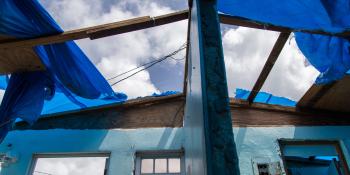Habitat aids in Puerto Rico hurricane recovery
In September 2017, in the span of just a couple of weeks, back-to-back hurricanes Irma and Maria devastated Puerto Rico, wiping out infrastructure, livelihoods and homes. Two years later, through a multi-year, multi-faceted approach involving private, public and nonprofit partners, Habitat is making progress in communities throughout Puerto Rico and advocating for changes that will build resilience and reduce delays in recovery when disaster strikes again.
It took nearly a year to return power to the whole island, and it will take many more to replace the lost shelter, as two major issues from the island’s near and distant past have played a large role in recovery efforts: land tenure and a shortage of construction workers.
With these challenges in mind, Habitat has organized its disaster recovery work to focus on:
- Repairs, rehabilitation of existing structures and new construction.
- Capacity building for families, for the construction sector and for increased community resiliency.
- Security of tenure/property ownership.
- Knowledge sharing.
Habitat began repair work as soon as possible in Caguas and Bayamón and expanded to four other municipalities: Yabucoa, San Juan, Carolina and Loiza. In addition to these six communities, repair work will expand into Guayama, Santa Isabel, Patillas, Salinas and Arroyo. At the same time, the rehabilitation of existing housing units is slated to begin and finish in San Juan and Guayama, and construction of new homes is slated to begin in Guayama.
For Juan Antonio, partnering with Habitat has meant finally replacing the blue tarps that have covered his home for the last two years. His new hurricane-hardened roof includes extra reinforcements to make him and his home more resilient against future disasters. He wasn’t sure that his home of 23 years would ever be habitable again — let alone rebuilt better and stronger than before. “It’s like when you’re in the dark, and you start to see a little bit of light,” Juan Antonio says of Habitat’s help. “Over time, that light gets bigger — with hope and with happiness.”
In addition to directly partnering with families like Juan Antonio’s to improve their shelter, Habitat also is focusing on building up the skills of construction workers on the island and investing in the recruitment and training of new laborers, with a special focus on getting women into the construction trades. Through our efforts, local construction workers have completed both construction safety and comprehensive training from the Occupational Safety and Health Administration. Additional trainings, including timber frame roof repairs, are next up.
Habitat also is working to address land titling issues. More than half of Puerto Rican families don’t have documents proving that they own their land, which can delay rebuilding. We are working at the household level to help families legalize their title status and at the community level with local organizations dedicated to solving Puerto Rico’s tenure issues. We also are a part of a policy working group founded with partners Center for New Economy, University of Puerto Rico Law School and ReImagina PR. Leveraging Habitat’s national platform, the group will take recommendations from grassroots coalitions to the government of Puerto Rico and national stakeholders.
We have also acted as a bridge and amplifying voice for organizations, institutions, municipalities, the government of Puerto Rico and disaster survivors working together to speed up and improve the quality of Puerto Rico’s recovery.
“I looked for help in so many different places,” Juan Antonio says. “Thanks to Habitat, I can come home again.”
